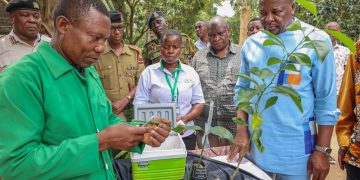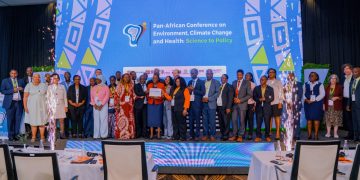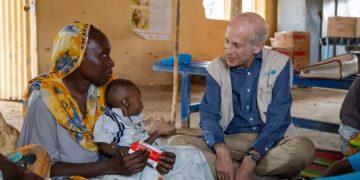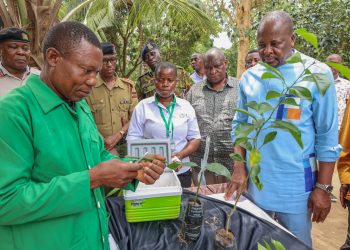In the sun-scorched plains of Turkana County, northern Kenya, a silent affliction creeps beneath the skin — often entering the body through nothing more than a prick that some locals attribute to a thorn, while some say it is from a prick from sharp objects like nails or fish bone.
Mycetoma, a Neglected Tropical Disease affecting vulnerable populations in remote areas such as Turkana, has been dubbed “the most neglected of the neglected diseases,” it continues to deform, disable, and devastate lives across this remote region — with very little recognition and response it deserves because of very low awareness.
Joyce has lost her leg, Erot is fighting for his, and Mark Ekaru, once budding musician and fisherman cannot easily mingle with people as he used to, before his ailment, he has to cover his foot whenever he is with people.
For Joyce Loote Lokonyi, a mother of three from Namadak location Kalokol, Turkana Central says that her predicament started with a simple thorn prick. She removed it, but the swelling never left. Pregnant at the time, she was told by doctors that treatment could not begin due to her condition. By the time her baby was born and medication was started, it was too late. A biopsy confirmed mycetoma, not cancer. But months of delays, worsening pain and a bone-eating infection left doctors with no choice —other than amputation.

“I had no idea something so small could lead to this,” Joyce says, “I took a long time before going to hospital and by the time I went to the hospital I was also heavily pregnant, the doctors told me to deliver first then come back for my leg medication, She said adding that “by the time I delivered and came back for my legs medication, the doctors told me that the disease had eaten all my toe bone and I was to be amputated.”
Because of the cost of attending post-surgery clinic appointments, she was forced to relocate 35 kilometers from her home closer to Lodwar for regular clinic visits.
Mycetoma is a chronic infection caused by fungi or bacteria. It slowly forms tumor-like swellings under the skin, producing pus-filled nodules and burrowing deep into muscle and bone. If not treated early — which, in Turkana, is nearly always the case — amputation becomes the only hope of survival.
Erot Ekeny, a 48-year-old father of eight, has been grounded by his illness. A proud pastoralist, he can no longer walks, tend his livestock, or feed his family.

And now he is grounded both by the pain but also an out of pocket cost which he says that a one-way trip from Kalokol to Lodwar for treatment costs him Shs 2,000 — a fortune he barely has. “I have nothing left,” he murmurs. “The drugs that I had initially been given were at least helping me the ones the doctors gave me last time are not helping me.”
He complains while receiving a new batch of itraconazole, he had been put on an alternative anti-fungal because the drugs he was using had been out of stock.
Mark Ekaru, 28, got pricked by a suspected fish bone in 2014; he thought it was just a boil. It wasn’t until ten years later in 2024 that he sought help and was diagnosed with mycetoma. “They opened the wound, took samples and when the results were out they told me I had to take medication every day.” Mark has been on medication ever since 2025 battling frequent drug shortages.

In Turkana County, most mycetoma patients are ostracized, treated as cursed or contagious. Children stop going to school because of stigma associated with the disease. Women cannot marry because of myths associated with the disease. Men spiral into depression because the disease makes them unable to work or provide for their families. In a society where livelihoods depend on labor mostly pastoralists and fishing, losing a foot or leg is tantamount to losing a future.
A Disease Buried by Silence
According to Dr James Ekiru Kidalio, Director of Medical Services in Turkana, despite its horrifying impact, mycetoma remains under the radar.
He adds that,” it is not a notifiable disease, drugs to treat it absent from Kenya’s essential medicine list, and with weak health systems the correct data of the disease is rarely captured.”
He says that there are treatments for mycetoma, “Treatment depends on the cause,” says Dr. Kidalio. “If it’s fungal, we give antifungals. If bacterial, antibiotics. But drug availability is erratic, and it takes years to get a proper diagnosis.”
“There are so many stigmas associated with the disease,” says Dr. Kidalio, There is also poor health seeking behavior in the community and by the time they come forward, it’s often too late.”
Numbers that Don’t Lie — But Remain Hidden
Between 2013 and 2022, researchers estimated a 1.46 percent prevalence of mycetoma in Turkana. But the real figure is likely higher — much higher.
According to James Ekamais, NTD coordinator Turkana County, most Mycetoma cases are buried in unreported medical records. Because of poor health seeking behaviors and traditions, diagnoses are delayed for years.

He adds that “there is no point-of-care diagnostic test. Only Lodwar County Referral Hospital — one out of 286 facilities — can identify the disease. And often, drugs supply is erratic.”
He says that the county is following up on 115 cases and the cases are increasing in numbers.
“We now have 115 known patients under treatment. That’s only the tip of the iceberg.”
A Long, Hard Road — and a Ray of Hope
According to experts Treatments for eumycetoma are long, expensive and some require adherence of >90percent to be effective when combined with surgery.
The standard treatment, Itraconazole, is taken twice daily for 12 months, but requires food for proper absorption — a huge hurdle in food-insecure Turkana. The cure rate remains below 40percent.
According to Dr Borna Nyaoke, Head of Mycetoma at the Drugs for Neglected Diseases initiative (DNDi Mycetoma causes disability, stigma and also mortality in these people thus DNDi is working to provide a safe, effective and affordable drug for its treatment.
“It costs up to $5,000 per patient — diagnostics, surgery, hospital stays, and drugs,” says Dr. Borna “For many in Turkana, that might as well be unaffordable.”
“We completed the world’s first double-blind randomized clinical trial in Sudan. It showed that when the current standard of treatment (Itraconazole) is taken with a compliance of >90% for 12 months and surgery is conducted at the 6 month time point then there’s a high chance of cure. The investigational product (fosravuconazole) also has high cure rates in similar circumstances. Fosravuconazole only needs to be taken once a week has no safety issues and few drug to drug interactions. We are thus working with the Mycetoma Research Center in Sudan and Eisai Co. Ltd. in Japan for its registration in Sudan,” She explained.
She added that “As we work on also increasing access to treatment globally we’re also working on identifying other high burden countries and regions through our epidemiological studies which are currently ongoing in Ethiopia, Senegal, India and Kenya.”
DNDi is also working to develop a preclinical mouse model to design future clinical trials with our partners- Erasmus mc and Antwerp University, she added.
But change may be on the horizon
In November 2023, DNDi announced the results of the world’s first clinical trial for mycetoma conducted in Sudan. The new drug, Fosravuconazole, showed 85 percent efficacy, requires just one weekly dose, and does not need food to be effective.
“As we await its registration in Sudan we are planning on treating 100 patients with eumycetoma with fosravuconazole through the Kassala University Hospital Mycetoma Center with the Early Access Cohort Protocol. Dr Borna said adding that, “We have collected over 1400 Mycetoma cases in hospital and laboratory records in India and Senegal in our just completed Retrospective Data Collection Study.”
She says that DNDi is also planning on screening 100,000 people for Mycetoma in Ethiopia and Senegal.
“35,000 have already been screened in Ethiopia, awaiting confirmation of the disease from patients referred to the hospital for diagnostics.”
“This drug is a potential game-changer,” says Dr. Bona. “With Fewer side effects, easier administration — and cheaper- The new drug- Fosravuconazole only has to be taken once a week (200mg) but also for 12 months with surgery. As we work towards its registration we hope it will be more affordable.”
DNDi, which has worked on mycetoma for over a decade in Sudan, has now launched studies in Turkana to map the disease’s spread.
The Path Forward: Awareness, Access, Action
Kidalio attributes Turkana’s harsh environment — dry, hot, and with limited infrastructure — as a perfect breeding ground for this insidious disease. He observes that most pastoralists and fishermen often walk barefoot, exposing themselves to soil- and water-borne pathogens.
According to Dr Kidalio, Illiteracy rates top 82percent, and 45 km distances between villages and clinics are common.
“Until we prioritize prevention, this disease will keep amputating our future,” Kidalio
The Turkana health system, though overstretched, is fighting back. With DNDi’s support, each sub-county now has a Mycetoma focal person tracking cases. But there is no national budget, no procurement pipeline, and no preventive program in place.
The Untold Cost
The real cost of mycetoma isn’t just medical — it’s emotional, societal, and generational. It’s Joyce, limping home on crutches to her three children. Erot, staring hopelessly at a field he can no longer tend. Mark, living with pain and confusion for over a decade.
Turkana’s cry is clear: recognize us, treat us and care for us because mycetoma may be neglected by the world — but its pain is felt deeply by those it touches.
“A person without a foot cannot build a nation,” says Dr. Kidalio. “If we don’t act now, we are condemning generations to suffering.”















